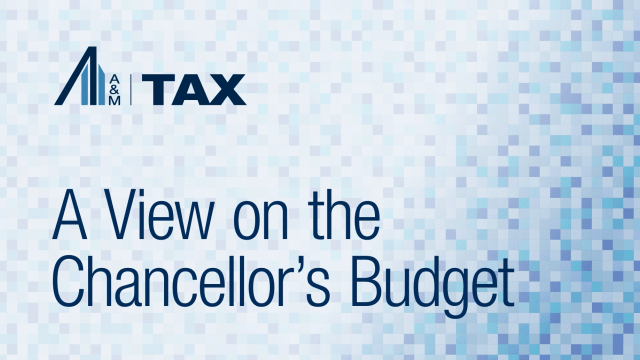The Fog Has Lifted: The IRS Issues Proposed Regulations under Section 162(m)
On December 16, 2019, the Internal Revenue Service (“IRS”) released proposed regulations (REG-122180-18) under Internal Revenue Code (“IRC”) section 162(m), which is the tax provision that generally imposes a $1 million annual limit on deductions by a publicly held corporation for compensation paid to covered employees. In 2017, the Tax Cuts and Jobs Act (“TCJA”) amended section 162(m) by expanding the definition of publicly held corporation and covered employees, and by eliminating the highly utilized performance-based compensation exception. Following the TCJA amendments to section 162(m), the IRS issued Notice 2018-68 (the “Notice”), which provided further insight to the TCJA amendments.
The IRS released the proposed regulations, which generally follow the guidance issued in the Notice. A&M believes the areas where companies will be impacted the most include the definition of a covered employee, specifically that once an employee becomes a covered employee, they maintain that status for life and the company must keep track of such status. Additionally, the IRS has provided guidance on the complicated issue of compensation paid by a partnership to a covered employee who provides services to the partnership. A&M knows these issues are tricky and therefore we have attempted to provide insightful direction and explanations of the proposed regulations. Below is a list of the key areas addressed in the proposed regulations:
- Definition of publicly held corporation
- Definition of covered employee
- Privately held corporations that become publicly held
- Applicable employee remuneration
- Grandfather rules
- Coordination with IRC section 409A
1. Definition of Publicly Held Corporation
A publicly held corporation is defined in the proposed regulations as any corporation that issues securities to be registered under section 12 of the Exchange Act, or that is required to file reports under section 15(d) of the Exchange Act. Note, however, that a corporation is not subject to IRC section 162(m) if its obligation to file reports under section 15(d) of the Exchange Act is suspended.
Additionally, an entity’s status as a publicly held corporation is determined as of the last day of its taxable year. If a corporate subsidiary of a publicly held corporation separately registers or files under section 12 or 15(d) of the Exchange Act, then it is treated as a separate publicly held corporation.
Furthermore, the proposed regulations explain that an S corporation or an S corporation parent of a qualified subchapter S subsidiary (“QSub”), would be considered a publicly held corporation if it issues securities pursuant to section 12 or files reports under section 15(d) of the Exchange Act (i.e. the S corporation has publicly traded debt).
Lastly, a publicly traded partnership which is treated as a corporation for federal tax purposes is considered a publicly held corporation if, as of the last day of its taxable year, its securities must be registered pursuant to section 12 or reports filed pursuant to section 15(d) of the Exchange Act.
The IRS rejected comments pertaining to foreign private issuers (“FPI”) being excluded from section 162(m). In conjunction with congressional intent and legislative history of the TCJA, an FPI is a publicly held corporation if it is required to register its securities under section 12 or file reports under section 15(d) of the Exchange Act.
The IRS and the Treas. Dept. confirmed that under section 162(m), a publicly held corporation includes an affiliated group of corporations (as determined pursuant to section 1504). However, the proposed regulations modify the original affiliated group rule under section 162(m) to now state that an affiliated group includes a parent corporation that is privately held and its subsidiary that is publicly held. Furthermore, if a disregarded entity is owned by a privately held corporation and the disregarded entity is an issuer of securities that are registered under section 12 or files reports under section 15(d) of the Exchange Act, then the privately held corporation is treated as a publicly held corporation for section 162(m) purposes.
2. Definition of Covered Employee
The proposed regulations remain consistent with the Notice, legislative history, and the Securities and Exchange Commission (“SEC”) executive compensation disclosure rules when defining a covered employee. Under section 162(m), a covered employee includes the CEO, the CFO, and the next three highest compensated executive officers for the taxable year. The proposed regulations confirm that an employee may be among the highest three compensated executive officers even if their compensation is not required to be reported in the corporation’s proxy statement via the summary compensation table. Additionally, if an employee is considered a covered employee for any taxable year after December 31, 2016, then their compensation will always be subject to the deduction limit, even after separation from service.
If the tax year and the fiscal year of the corporation differ, then the proposed regulations adopt the SEC rules for determining the amount of compensation for the three highest compensated executives. The SEC determines compensation for the three highest compensated executives by using the corporation’s tax year end. This rule is applied to tax years beginning on or after December 20, 2019. For instance, if a corporation has a fiscal year end of October 31 and a taxable year end of December 31, then the officer’s compensation will have to be calculated based on the 12-month taxable year end of December 31. The effective date for the definition of covered employee is taxable years ending on or after September 10, 2018. Furthermore, the rule for determining compensation when tax and fiscal years differ is effective for taxable years beginning on or after December 20, 2019.
Predecessor Corporation
A section 162(m) covered employee also includes any employee who was a covered employee of any predecessor of the taxpayer corporation for any taxable year beginning after December 31, 2016. If an employee is a covered employee for one taxable year, either of the publicly held corporation or its predecessor, then the employee remains a covered employee for all subsequent taxable years.
The definition of a predecessor corporation includes a publicly held corporation that becomes privately held, and subsequently becomes again publicly held within 36 months after the due date of the corporation’s federal tax return (excluding extensions) when it was previously publicly held.
The proposed regulations define predecessor of a publicly held corporation by looking at the type of corporate acquisition event that occurred. Corporate acquisition events include 1) corporate reorganizations, 2) corporate divisions, 3) stock acquisitions, and 4) asset acquisitions. For example, if a publicly traded company acquires another publicly traded company then the covered employees of the target are attributed to the buyer.
The predecessor corporation rules will apply once the final regulations are published, but in the interim taxpayers should use the proposed regulations and a good faith interpretation of the term “predecessor.”
3. Applicable Employee Remuneration
The proposed regulations have replaced “applicable employee remuneration” with “compensation.” Additionally, the proposed regulations provide that the deduction limit applies to compensation paid while the covered employee was employed, retired, and amounts paid by the company to third parties.
The proposed regulations have provided much anticipated guidance on compensation paid by a partnership to a covered employee. Historically, compensation paid by a partnership to a covered employee has been an issue the IRS has taken a “no-rule” position on a topic that the IRS has only issued four private letter rulings on, solely based on facts and circumstances. Under the proposed regulations, compensation now includes amounts paid to a covered employee (who provide services to the partnership) by a partnership, so long as the publicly held corporation is allocated a share of the partnership’s compensation deduction.
This rule is effective for taxable years ending on or after December 20, 2019. Furthermore, the proposed regulations have implemented a grandfather rule for written and binding compensation agreements entered on or before December 20, 2019.
4. Privately Held Corporations that become Publicly Held
Under Treas. Reg. section 1.162-27, there was a rule which provided transition relief to privately held corporations that become publicly held, known as the initial public offering (“IPO”) exception, or the IPO transition relief rule. The proposed regulations do not adopt the IPO transition relief rule. Thus, IPOs and any other go-public events occurring on or after December 20, 2019, will not receive shelter under the IPO transition relief rule. Under this new rule, continued deductions after an IPO will no longer be permitted, and it retroactively applies the section 162(m) limitation to compensation paid prior to an IPO if the compensation is deducted in the year of the IPO.
5. Grandfathering Rules
The proposed regulations implement the grandfathering rules found in the Notice. Previously the grandfathering rules applied to compensation paid pursuant to a written binding contract that was in effect on November 2, 2017 and has not been materially modified. Under the proposed regulations, like the Notice, grandfathering is permitted so long as the corporation is obligated to pay pursuant to the contract. If amounts paid are in excess of the amount the corporation is obligated to pay pursuant to the written binding contract, then the amounts in excess are subject to the section 162(m) rules. Furthermore, the request for a grandfather safe harbor rule was declined and not included in the proposed regulations, however the IRS and Treas. Dept. have requested additional comments on this matter.
In addition to the above-mentioned provisions of the proposed regulations, there are several miscellaneous provisions as well. Regarding clawbacks, the proposed regulations provide that the compensation will remain grandfathered until the corporation has the right to claim the compensation under its clawback policies. The proposed regulations also address non-account balance plans and earnings, in that the grandfathered amount is the amount that the corporation is obligated to pay as of November 2, 2017, and not additional earnings or increases in benefits made after November 2, 2017 under these plans. Severance agreements have a slightly different treatment from the above in that amounts may be grandfathered only if the severance amount is based on compensation elements the employer is obligated to pay as of November 2, 2017.
The proposed regulations also address material modifications and adopt the definition of material modifications from the Notice. However, one clarification under the proposed regulations is that if amounts are paid to the individual via multiple contracts, and one contract is materially modified, then the other contracts are not considered to be modified unless the modification impacts the amounts paid under the other contracts. Additionally, accelerated vesting is not considered a material modification.
6. IRC Section 409A
Section 409A is to be amended so that an employee may delay the scheduled grandfathered payments and not delay the payment of non-grandfathered amounts. As a result of the amendment, the delay of the grandfathered amounts would not be treated as a subsequent deferral.
Alvarez & Marsal Taxand Says:
The proposed regulations provide much anticipated guidance and expansion of the Notice. However, given the complexity and changes associated with the grandfathering rules, covered employee definition and determinations, and the withdrawal of the IPO transition relief rule, many challenges lay ahead for companies determining the impact of section 162(m). If you have any questions, please feel free to reach out to the compensation and benefits professionals at Alvarez & Marsal. We are uniquely qualified to assist corporations and individuals with determining the reach and impact of section 162(m).






